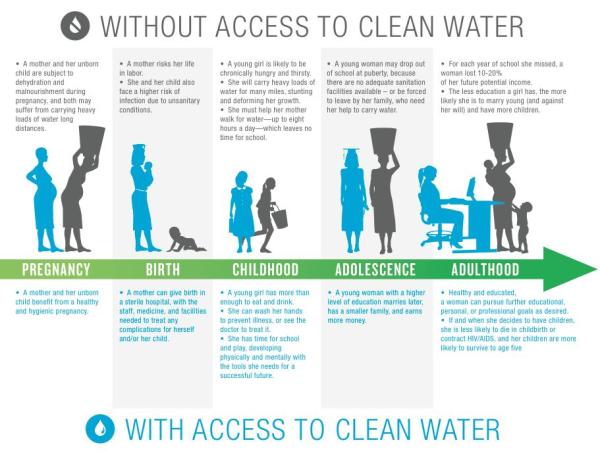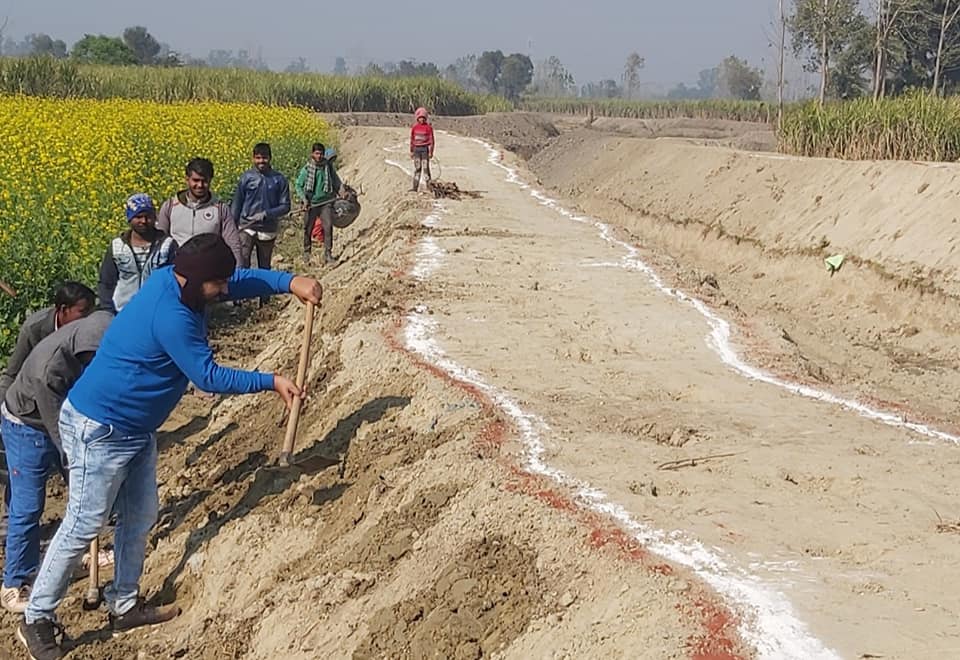
Photo: Rejuvenation of Kali River East, India. Photo courtesy: Raman Tyagi/NEER Foundation
Much has been said and written about what an year 2020 has been for all of us!
The good new is that now the UN-Decade of Action has begun. For those reading and who would like more information on Decade of Action, please visit this link.
Wishing everyone a very happy, healthy and much better 2021-2030 from theflipsideofdevelopment!
This post Decade of Action is here now! first appeared on theflipsideofdevelopment.wordpress.com.

The context:
Rarely do I get the chance to check out all the categories on my blog’s list. On Environment Day, June 05 2020, this year I got such a change, to find out how the debate around sustainability has Changed and the Challenges forward. This year World Environment Day was not a normal one. Needless to remind anyone that we are experiencing one of the worst pandemics ever. In the midst of it all the recent rise has exposed the systematic inequality the world over. The pandemic did not differentiate between the developed and the developing countries as we define them.
This year:
This year, I decided to do something different altogether to mark the world environment day. It’s not one of the happiest one that I shall remember for years to come, however still important nevertheless. I was invited to be on a panel discussion by one of my oldest colleagues and collaborators in India.
According to an old saying shared by one of the panelists: A wise man takes lessons from others’ mistakes, a normal person learns from his own mistake however, a fool doesn’t even learn from his own mistake. We are likely to set on the course of not taking a lesson from our mistakes if we do not emerge stronger and resilient as a global community.
In conclusion:
Please watch and contribute.
*Agenda.
– Environmental Debate – Changes in the Problem Statement.
– Human Behaviour Changes – Impacts on Sustainability Debate.
– Changing Economics Policy Shifts & Challenges.
– Exclutionism, Politics & Wars – Emerging World.
*Where: https://www.youtube.com/watch?v=D5py-K2srR4
*When: 7 PM IST, June 05 2020 on youtube.com/ballotboxindia
*Panel: Rakesh Prasad (Senior Researcher BallotboxIndia.com), Raman Kant Tyagi (Director and Environmentalist NEER Foundation) Pallavi Bharadwaj (Global Developmental Professional), Dr. Venkatesh Dutta (Environmentalist and Associate Professor BBAU), Anand Prakash (Urban Designs Expert) AECOM
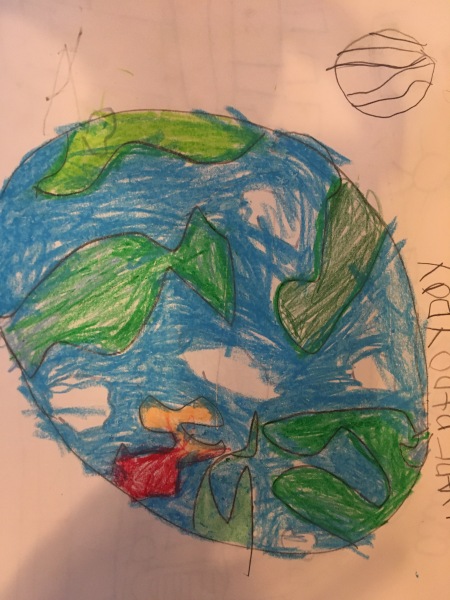
- Earth Day 2020 ©Pallavi Bharadwaj
Approx. 10 mins read. < 1050 words
The Context:
When it came to Water, Sanitation and Hygiene (WASH), growing up in India, I had two extreme case scenarios in my two sets of grandparents homes. My paternal grandmother never turned the tap off, while doing the dishes and let it flow, even if it was just a little trickle (according to her). This used to irk my mother and she complained under her breath urging my grandmother to turn the tap off, as politely as an Indian daughter-in-law could have done in the 1980s. On the other hand, in my maternal grandparents’ home, I never saw anyone use soap to wash their hands, even after using the toilet! My maternal grandparents always used ashes from the burned firewood or mud to clean their hands, and also a few copper utensils to make them shine. This could be very confusing to a toddler’s eyes and mind. My own adoptee grandparent did not condone either practice, and made sure to inculcate the habit of washing hands with soap, and keeping the tap off while rubbing the soap.
So, why am I going down the memory lane now? That little practice from my childhood, speaks volumes about the need of both behavioral change in the developed countries (to save water while washing hands, brushing teeth, shaving, doing dishes and so on), and in developing countries to use soap and not traditional items (sand, ash and mud) to wash their hands with water in the time of COVID-19 and beyond.
Our World today:
Safe WASH practices are vital for human well-being. However, 1 in 3 people (approximately 2.2 billion) still lack safe drinking water, 4.2 billion do not have access to safely managed sanitation services, and 829,000 people die annually from unsafe water and related sanitation and hygiene around the world.
In India, where only a fifth of all households out of 1.3 billion have piped running water, frequent handwashing is a challenge. This is a common scenario for most in sub-Saharan African countries too, where 75 percent of people living in rural areas lack adequate facilities for handwashing. Clean water and good hygiene is the absolute minimum that’s needed to combat the spread of the new coronavirus. But in sub-Saharan Africa, the World Bank reported that around 75 percent of people living in rural areas live in homes that lack adequate facilities for handwashing. One charity working in the Western Province of Kenya found that 95 percent of the households they visited had no access to running water. And that’s only part of the problem. Nearly a billion people experience only partial access or regular shutoffs even when they do have piped water, making frequent hand-washing difficult or impossible.
Major health organizations and experts advise washing hands more frequently – for at least 20 seconds – to prevent outbreaks. A report released last year by the WHO and UNICEF found that as of 2017, 3 billion people worldwide, or 40 percent of the global population, lacked basic facilities at home to wash their hands with soap and water. More than 670 million people were still defecating in the open, and another 700 million were using unimproved, unsanitary facilities.According a recent article by WRI, that’s only part of the problem. Nearly a billion people experience only partial access or regular shutoffs even when they do have piped water, making frequent handwashing difficult or impossible.
Pertinent solutions to speed up WASH access:
1. Engineering for Change’s Solutions Library: features a number of safe handwashing products and services, such as the tippytap. These solutions make setting up handwashing stations in the communities very easy. These solutions are market tested and can provide low to no-cost options to areas, where soap is considered a luxury item.
2. Financing the gap: As the global WASH community races towards 2030 to meet SDG 6, new sources of finance and better use of existing ones for WASH projects are essential. A range of financing approaches can help address the diverse needs between and within countries, as well as incorporate measures that bolster resilience as illustrated in this article from New Security Beat, Wilson Center’s blog.
3. Providing WASH collectively to the communities in need: Separating water supply from sanitation services will push us back many years. Equitable distribution of water for communities, agriculture and industries shall help combat COVID-19 crisis and prepare for future events. Grassroots organizations, such as Gravity Water in the US and NEER Foundationin India, are working towards addressing the current crisis via a collaborative and ecosystems based approach.
4. Affordable WASH for all: For many communities, especially in subsistence economies (farming and related occupation), affordable might even mean “free”, according to Mr. Leo Heller, Special Rapporteur on the human rights to safe drinking water and sanitation during one of the recent RWSN’s webinars. This affordability is especially imperative now, in the time of COVID-19, so that these communities can spend their limited resources to buy basics such as food, medicines and soap.
5. Bringing nature wherever possible in our daily lives:
Sponge cities and now biophilic cities, cities that aspire to be more rich in nature within their unique and diverse environments and where the planning and design abundantly incorporate the natural world into the daily lives of residents, are the concepts that we need more of. Richmond, VA is the latest biophilic city, following Singapore as one of the international ones.
In conclusion:
A combination of all the above along with a global consensus on speeding the delivery of much-needed resources would go a long way in creating resilient communities. April 22, 2020, marks 50 years of commemorating Earth Day. In that time nations have coalesced around policy and technology that reduced acid rain and depletion of the ozone layer, and institutions have launched to conserve land and wildlife, improve the air, clean the oceans and lay foundations for mitigating climate change. As a planet, we have been solving problems in the inequitable distribution and degradation of natural resources for 50 years. We are more than capable of doing it now, as we work together to meet the UN SDG 2030 Agenda for all and leave no one behind.
Disclaimer: This article is a combination of articles that originally appeared on Engineering for Change and World Water Reserve. It has been modified for the readers of this blog. To read the original articles, please click the names above.

EarthHour2011 ©Fahad Ali Shah
< 4 mins read. Approx. 350 words.
The context:
On Saturday, March 28, 2020 at 8:30 p.m, all around the world, it’s “Earth Hour,”, when a lot of public and private lighting will be switched-off for 60 minutes. Earth Hour is a grassroots movements for the environment and, this year, perhaps also a moment of solidarity for the planet, and all of us upon it.
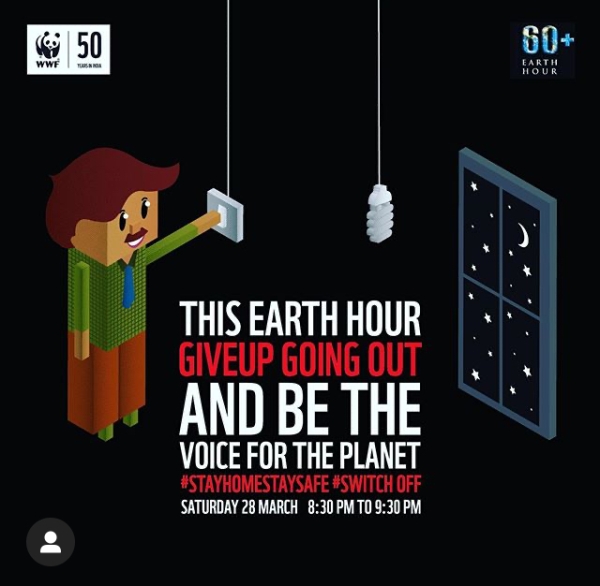 Personal context:
Personal context:
2011 was my last year to participate and celebrate in the Earth Hour at WWF- India. The title picture of this post is from that year. It’s been a bitter sweet feeling to observe earth hour in my new home for the past 8 years. It reminds me of a happier time when I was with my school friends and colleagues, who have now become lifelong friends from WWF-India, and beyond. Now I try my best to spread the word and cheer amongst my family and friends by doing bit online.
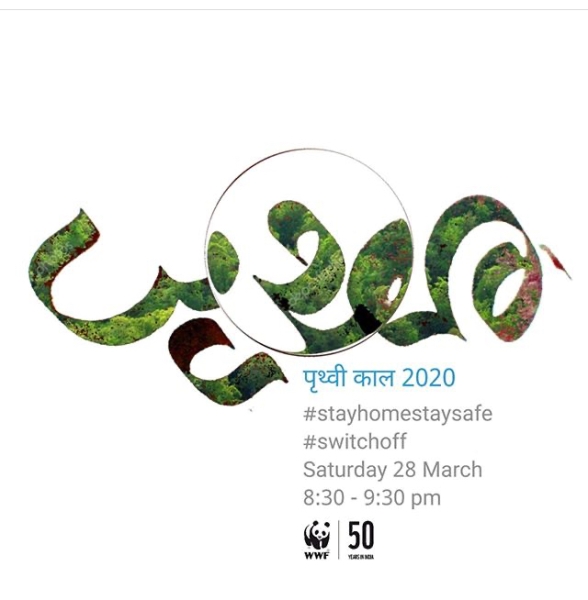
It is comforting to read Earth Hour this spelled out in Hindi, which is my mother tongue.
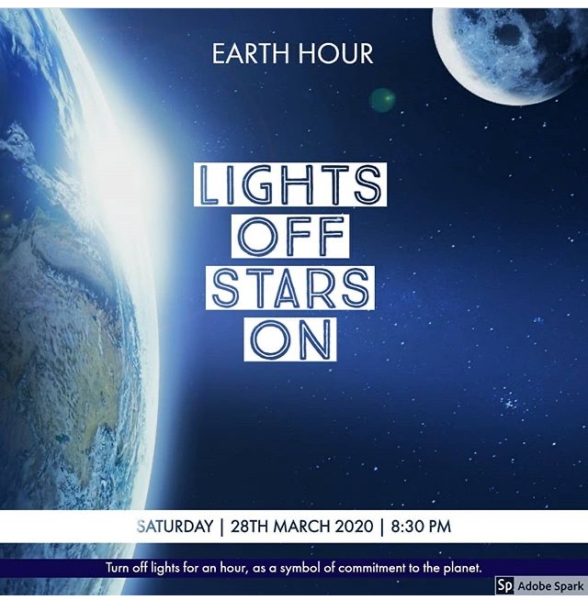
Now more than ever it’s important to remember that there is more to this world than us as an individual, our planet earth’s entire community, the space and beyond.
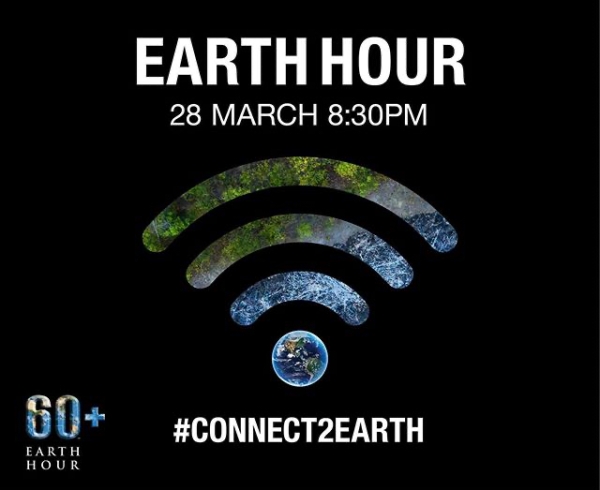
In COVID-19’s time, when all of us are confined to our homes, there are several ways we can connect to the planet earth. We can do this by tuning into live stream on youtube or facebook or spoify, watching nature based documentaries, listening to podcasts, sounds of nature on our devices, gazing at the stars, creating some art, craft or writing pieces to express our love and gratitude towards the nature and planet earth, and our family and friends. Last but not the least, you can sign the pledge to add your voice to earth hour by clicking here.
In conclusion:
I am am optimist at heart. I try to remember at all times that this too shall pass. Earth Hour shall come again next year. By doing our bit to help stop the spread of COVID-19, and contributing towards saving our planet earth, we will have a past to be happy and proud of then.
This post Earth Hour 2020: An obligatory annual post (a photo essay this year) first appeared on theflipsideofdevelopment.wordpress.com
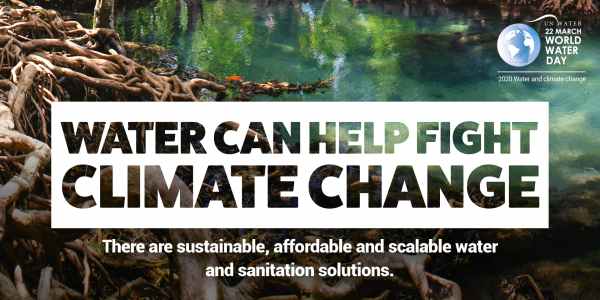
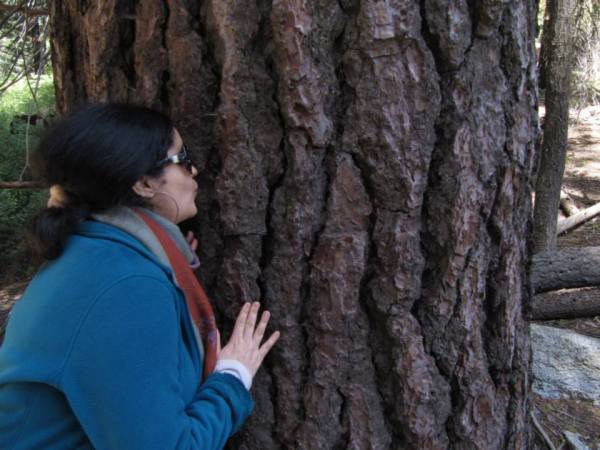
Yosemite and Giant Sequoia National Park, circa May 2015 ©Rohith Roy
Approx. 6 mins read <650 words
The context:
This post is to celebrate International Day of Forests, which is today on March 21. The United Nations General Assembly proclaimed 21 March the International Day of Forests in 2012. I was there on that day when it happened at the UN HQs in NYC. This is the reason why I feel motivated to write a post on the importance of forests in our lives year after year.
This year’s theme is ‘Forests and Biodiversity’. So why do we need to celebrate forests ahead of world water day, which is tomorrow? Here are some quick facts according to UN-FAO’s website:
- Forests are home to about 80% of the world’s terrestrial biodiversity.
- Forests and woodlands are made up of over 60,000 tree species.
- More than a billion people depend directly on forests for food, shelter, energy and income.
- Deforestation continues at an alarming rate – 13 million hectares of forest are destroyed annually and this accounts for 12 to 20 percent of the global greenhouse gas emissions that contribute to climate change.
All the water on planet earth today, whether in the oceans or seas (saltwater) or in our rivers, lakes, ponds (freshwater) is the same water that has been there since the beginning of time. Nature’s own filters, trees, have been doing this work silently for millions of years through a process called hydrological cycle aka as the water cycle.
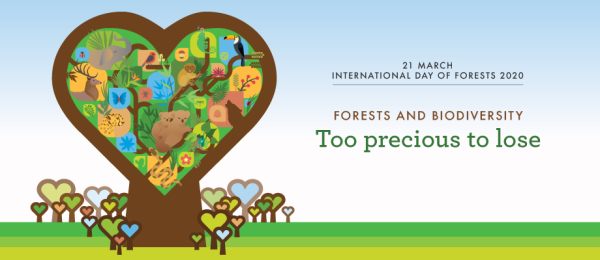
Across the world, communities have planted and protected trees for ages, to support themselves and the fragile ecosystems, in which they dwell.
Personal context:
Regular readers of this blog might have come across my past posts on the joys of growing up in a household in India, with a guava tree in the courtyard, and a mulberry tree at the entrance of that home. I also have my fondest memories of encountering some of the most interesting biodiversity, from a caterpillar to green parrots, while playing in those trees all summer long. I used to make sure to pick up only those guavas that the parrots and sparrows have tasted and approved back then. Looking back I feel so fortunate to have experienced that childhood and believe that it sparked the desire to learn more about these amazing trees and life that they support, eventually leading me to on to a lifelong path of learning about science, environment, water and global development.
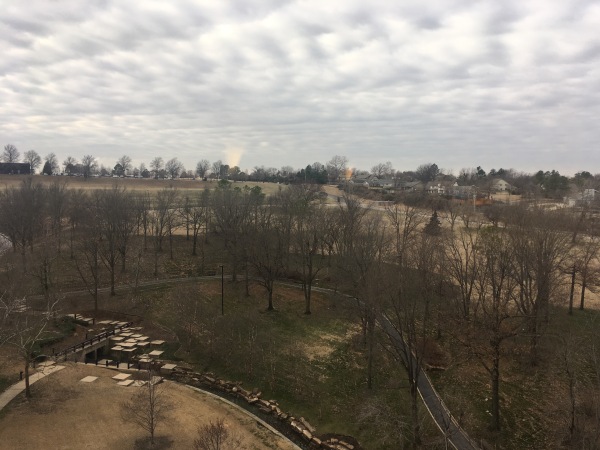
Urban forest in winter circa Jan. 2020 ©Pallavi Bharadwaj
I’ve been extremely fortunate to have the opportunity to have lived, worked and traveled to some of the most forested regions of the world. They range from the foothills of the Himalays in northern Indian states of Uttar Pradesh, Uttarakhand (Raja Ji National Park, Sanjay Van), Punjab and Himachal Pradesh, and Aravalis in Haryana and Rajasthan, to Yosemite National Park in the US.
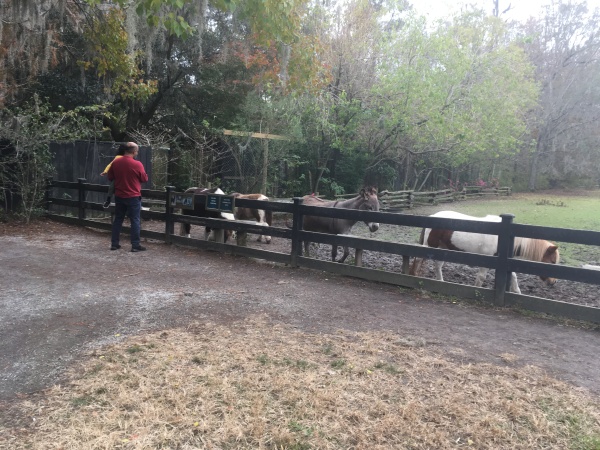
Magnolia Plantations. circa Nov 2019 ©Pallavi Bharadwaj
We try to inculcate the knowledge and importance of forests and biodiversity in our toddler, despite him being born and now growing up in mainly urban environs.
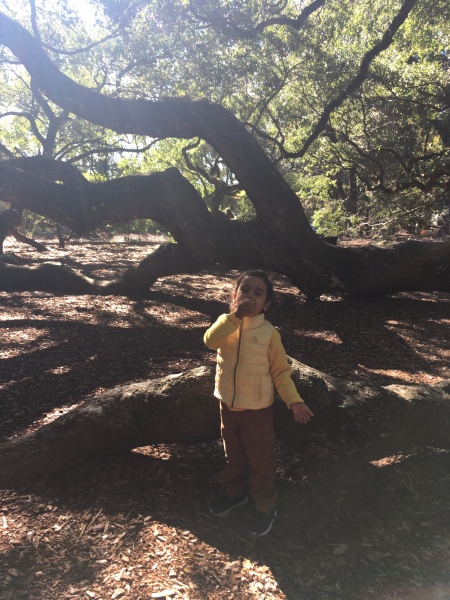
Angel Oak Tree, John’s Island, Charleston, SC circa Nov. 2019 ©Pallavi Bharadwaj
In conclusion:
Next time when you turn on the tap to fill a glass of water, open a packet to take a medication, write something on paper or buy a wooden furniture to build or decorate your home, just think of all the invisible ways in which the forests help us and touch our lives, and in what visible or invisible ways we can help the forests and biodiversity globally. In India vanaprastha (forest bound) means “one who gives up worldly life”. It is also a concept in Hindu traditions, representing the third of four ashrama (stages) of human life, the other three being (Brahmacharya, Grihastha and Sannyasa). I leave you with this video on the Japanese concept that they practice called forest bathing, or shinrin-yoku. Shinrin in Japanese means “forest,” and yoku means “bath.
This post Celebrating ‘forests and biodiversity’ ahead of water today first appeared on theflipsideofdevelopment.wordpress.com
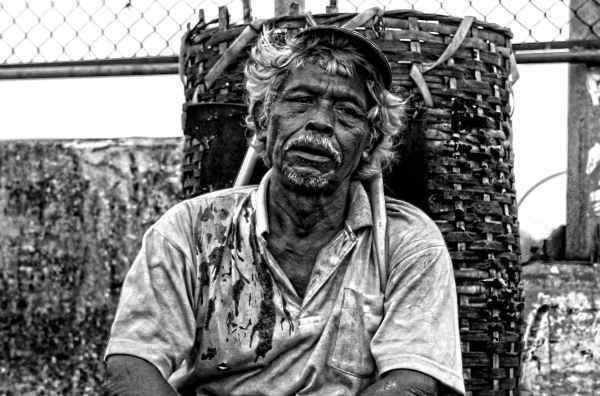
©Vijay Putra
<5 mins read. Approx. 505 words
The context:
On 26 November 2007, the UN General Assembly (GA) declared that, starting from the 63rd session of the GA, February 20 will be celebrated annually as the ‘World Day of Social Justice’. This year’s theme is “Closing the Inequalities Gap to Achieve Social Justice”
Personal context:
One of the very first projects, that I was part of in the early 2000s India, was funded by environmental equity and justice partnership. The goal of EEJP is ‘to secure environmental justice especially for the poor and the marginalized that are often expected to bear more than their share of environmental burdens’. That was my very first introduction to the concept of environmental equity and how it relates to social, demographic, caste and climate change justice beyond just the economic lens.
The world today:
Globally, the number of urban residents, who lack safely managed sanitation, has increased from 1.9 billion in 2000 to 2.3 billion in 2015, costing $223 billion a year in health costs, lost productivity and wages. In a recent analysis of 15 cities in the global south by WRI, 62 percent of sewage and fecal sludge is unsafely managed. This in on top of 780 million people, who do not have access to an improved water source.
In terms of combating air pollution, the Indian government, has tried to use anti smog water cannon to combat toxic air in nation’s capital, Delhi. They have also implemented something known as odd and even number of driving days for car owners based on their license number plates. 5 million residents were handed out face masks. Specialists have warned that inhaling Delhi’s toxic air is equivalent to smoking 2 packs of cigarettes a day. As in every episode of an environmental challenge, the poorest are the worst hit in this case as well. They have to go out, and work to earn their daily wages.
Urban heat island effect is another climate change related phenomenon that has undertones of environment injustice and unequal social equity. Tree covers and green spaces tend to remain in influential and wealthy parts of neighborhoods, especially in the cities. Therefore, urban heat island effects low income neighborhoods more.
In conclusion:
According to the UN GA, globalization and interdependence are opening new opportunities through trade, investment and capital flows and advances in technology (IT, AI and others). The growth of the world economy has resulted in development and improvement of living standards around the world. At the same time there remain serious challenges, including serious financial crises, insecurity, poverty, exclusion and inequality within and among societies. It will provide considerable obstacles to further integration and full participation in the global economy for developing countries, as well as some countries with economies in transitions. Ultimately, economically disadvantaged citizens shall be facing these challenges. Environment and climate change in the context of social justice shall become increasingly evident, in the absence of viable global solutions and make it harder to achieve SDGs for all.
This post ‘World Day of Social Justice 2020: talking environment equity and climate change’ first appeared on theflipsideofdevelopment.wordpress.com
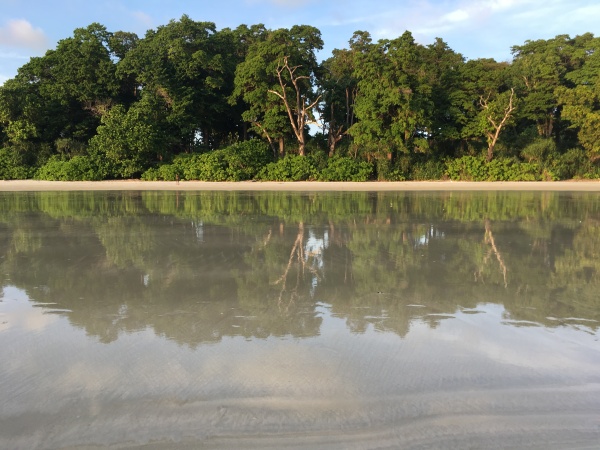
- Mangroves at Radha Beach in Andaman Islands, India, circa Nov. 2016 ©Pallavi Bharadwaj
<6 mins. read, approx. 595 words
Personal context:
One of my very first volunteer projects was on wetlands. Janhit Foundation, a small local environmental grassroots nonprofit, had undertaken a census of all ponds in and around Meerut district for the very first time. I was in-charge of translating that entire report from Hindi to English for a wider circulation among the funders, program partners and international experts. I am very fortunate and thankful to the wetlands as that project catapulted my interest and career in water resources management and global development. That assignment also helped me land my very first full time assignment as the first women Program Coordinator at Janhit Foundation in the early 2000s!

What exactly is a wetland?
A wetland is a place where water covers the soil or is near the soil surface for varying periods of time during the year. Some examples of wetlands that you might have seen are lakes, marshes, swamps, estuaries, tidal flats, river flood plains, mangroves, ponds (including vernal ponds) and even rice fields.
Ramsar Convention on Wetland:
Today marks the anniversary of 7 countries coming together in 1971 to protect wetlands through the Ramsar Convention. This number has grown to 171 countries as of 2019.
Why should you care?
I would say that if you have ever been to a beach, lake, forest, pond or any natural water body to relax and take a break, then you must care. Additionally to prove my point, these are the three key messages from the Ramsar convention for today.
- 40 % of the world’s plant and animal species live or breed in wetlands: Wetlands are an important habitat for biodiversity.
- Over 100,000 fresh water species can be found in wetlands
- Wetland biodiversity matters for life to thrive
- Swamp vegetation filters pollutants from water, which improves water quality
- Wetlands provide livelihoods for one billion people
- Rice grown in wetland paddies is the staple diet of nearly three billion people, while most commercial fish depend on coastal wetlands for part of their life cycle.
- Turtles, crocodiles, shrimps and others lay their eggs and rear their young in the mangroves (a type of coastal wetlands). See the title pic.
- 30% of land-based carbon is stored in peatlands. Peatlands, mangroves, seagrasses and salt marshes store carbon and matter for climate action
- Mangroves and coral reefs protect coastal communities during storm surges, hurricanes and tsunamis, which reduces risks of disasters by providing buffers.
- Wetlands provide ecosystem services worth USD 47 trillion annually, more than those from forests, deserts or grasslands
- Biodiversity is in steep decline and wetlands are disappearing three times faster than forests
- One million animal and plant species are threatened with extinction, with wetland species declining the most.
- 35 % of the world’s wetlands have been lost since 1970’s – causes include pollution from waste, draining or infilling for agriculture and construction, overfishing, over extraction, encroachment, rapid urbanization, among others.
- 25% of wetland species are threatened with extinction, including water birds, freshwater-dependent mammals, marine turtles, and coral-reef- building species
- Between 1970 and 2014, populations of fish, birds, mammals, amphibians, and reptiles declined by 60%
In conclusion:
It’s no surprise to say that it will take more than just one day to help protect the invaluable ecosystems that the wetlands are. It will take a combination of policies, technological innovation, market-based solutions combined with political will and individual efforts to reach that goal. If protected today, then the wetlands shall help alleviate the type of extreme events observed in not only cities like Chennai, India but also in most major inland and coastal cities of the world.
This article “Celebrating Wetlands and Biodiversity today” first appeared on https://theflipsideofdevelopment.wordpress.com
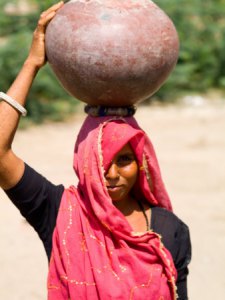 The context:
The context:
